About:
Did you know tough scales on desert tortoise's legs protect them from the spines of many desert plants? Learn more about desert tortoises.
Care & Wellness:
Their wild counterparts use tunnels and burrows to escape temperature extremes and danger, our desert tortoises have access to a built-in den off of their large habitat to encourage this natural behavior.
They can eat the desert plants in their habitat in between the “salads” that are fed 3 times per week.
Behavior:
- Their solitary lifestyle often leads to confrontation between males.
- Their burrows can be deep, up to 30 ft long, and serve as protection from extreme temperatures and predators.
- To escape harsher winter conditions, they hibernate from about November - March.
Endangered Status
- Vulnerable (VU)


